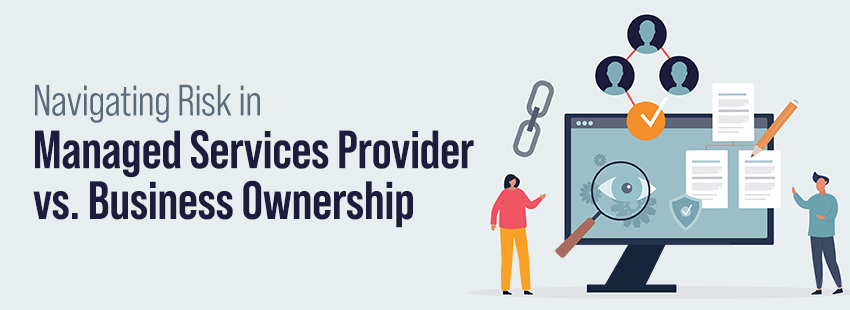Navigating Risk in MSP vs. Business Ownership
Who Owns the Risk
Companies often rely on managed services providers (MSPs) to streamline their IT infrastructure, enhance efficiency, and mitigate potential risks. As organizations increasingly embrace outsourcing, a critical question emerges: Who owns the risk—the managed services provider or the business they serve?
The Dynamics of Managed Services
With the intricacies of risk ownership and management in the MSP-client relationship, it’s evident that managed services entail entrusting specific business functions to external experts. This delegation allows companies to concentrate on their core competencies. However, while this arrangement offers numerous advantages, it introduces a labyrinth of potential risks.
Shared Responsibilities in Managed Services
Examining the dynamics of risk in managed services reveals a collaborative partnership where responsibilities are shared between the provider and the business. The delineation of tasks and risks must be explicitly outlined in the service-level agreement (SLA). Typically, the MSP assumes responsibility for day-to-day IT infrastructure management, cybersecurity, and specified services while the business retains strategic decision-making and oversight.
Navigating Operational Risks
Operational risks, critical for the smooth functioning of business operations, fall under the purview of MSPs. They bear the responsibility for service disruptions, system failures, and performance issues. Nonetheless, the client business also plays a pivotal role in risk mitigation by providing accurate information, participating in regular assessments, and promptly addressing concerns raised by the MSP.
Data Security and Compliance in the Digital Age
In an era dominated by increasing cyber threats and stringent data protection regulations, vigilance is imperative for both MSPs and clients concerning data security and compliance. MSPs are accountable for implementing robust cybersecurity measures and ensuring compliance with industry standards. Simultaneously, businesses must collaborate by sharing relevant information, adhering to security protocols, and educating their employees on best practices.
Challenges in Risk Allocation
Navigating the challenges of risk allocation involves addressing key issues. Ambiguities in SLAs can undermine the effectiveness of risk management, leading to misunderstandings and finger-pointing in the event of a risk materializing. Crafting a comprehensive SLA that leaves no room for interpretation is a joint responsibility.
Bridging Communication Gaps
Effective communication is pivotal, particularly in the realm of managed services. Miscommunication or inadequate information sharing can result in missed warning signs and delayed responses to potential risks. Establishing regular communication channels and mechanisms for incident reporting and resolution is essential to bridge any communication gaps.
Navigating Third-Party Dependencies
MSPs often rely on third-party vendors for specific services or tools, introducing additional risks. The client business may lack direct control over these external relationships, but the associated risks can impact both parties. Navigating this aspect of risk management requires transparent communication and due diligence in selecting trustworthy vendors.
Strategies for Effective Risk Management
Strategies for effective risk management involve collaborative risk assessments conducted periodically by both the MSP and the client. This proactive approach identifies potential vulnerabilities and threats, allowing preemptive measures to enhance overall business infrastructure resilience.
A Culture of Continuous Improvement
A culture of continuous improvement is vital for both parties. Regular reviews of processes, technologies, and security protocols help identify areas for enhancement. Fostering a mindset of adaptability enables the MSP and the client to collectively respond to emerging risks and stay ahead of the curve.
Investing in Cybersecurity Education
In the shared responsibility of cybersecurity, MSPs should invest in training their staff to stay abreast of the latest threats and mitigation techniques. Simultaneously, the client’s employees should undergo cybersecurity awareness training to recognize and promptly report potential risks.
Conclusion: Fostering a Symbiotic Partnership
In the intricate dance of risk ownership between MSPs and the businesses they serve, collaboration and communication emerge as paramount. While MSPs shoulder significant operational responsibilities, businesses can only partially absolve themselves of accountability. A well-crafted SLA, clear communication channels, and a commitment to continuous improvement lay the foundation for effective risk management. Ultimately, the partnership should be a symbiotic relationship where both parties actively contribute to the resilience and success of the business ecosystem, determining who owns the risk.





